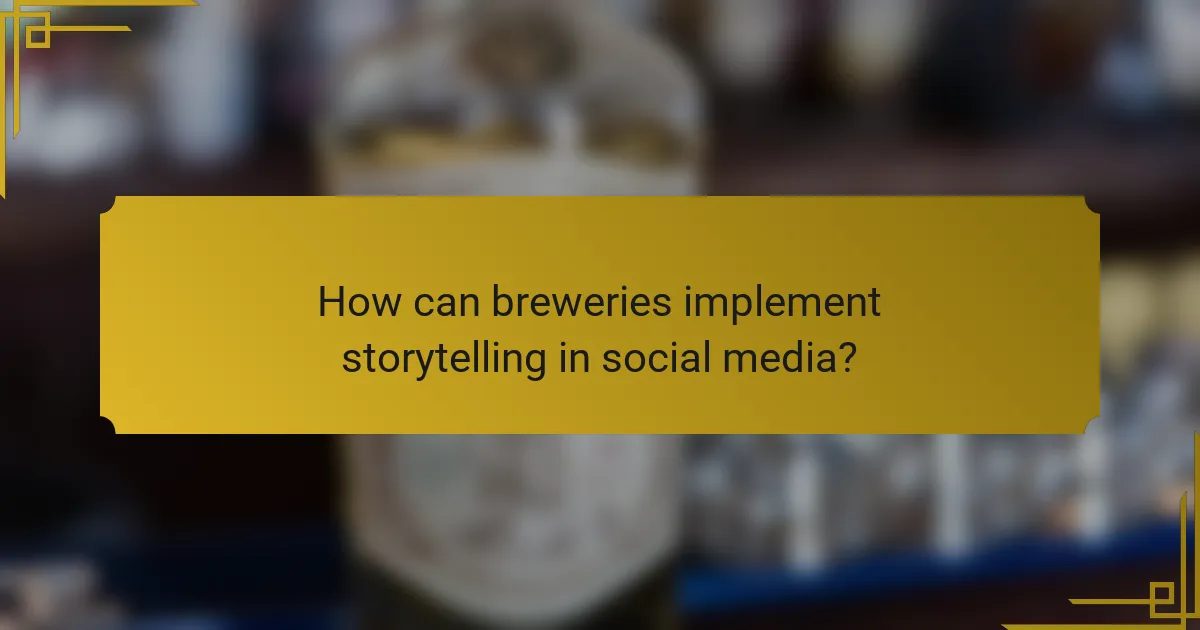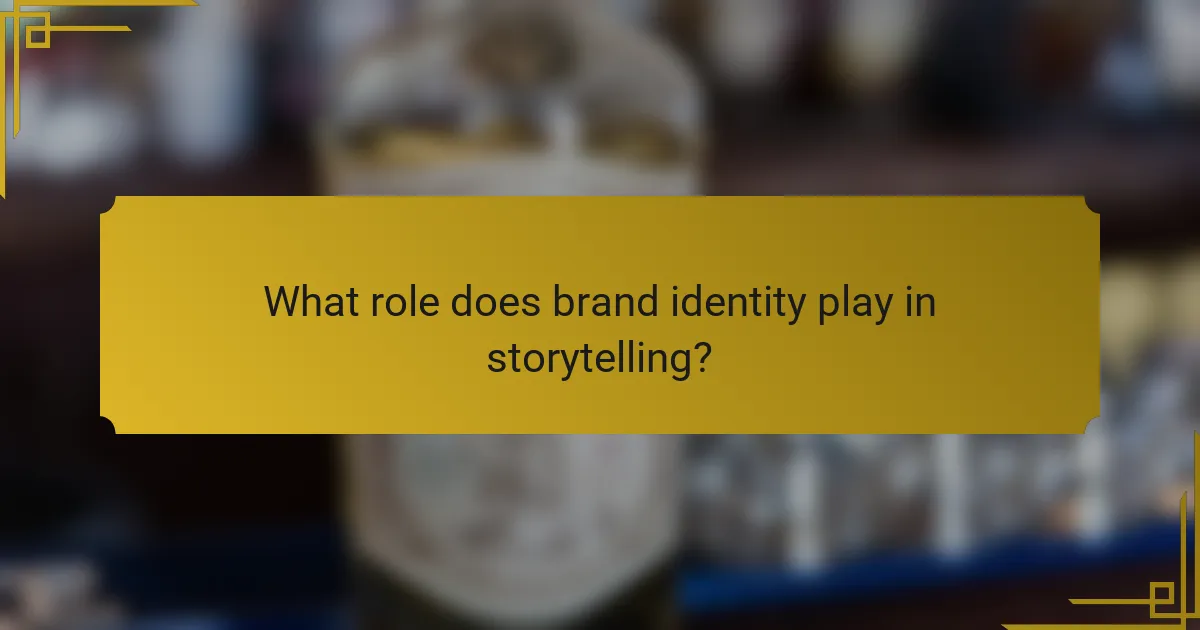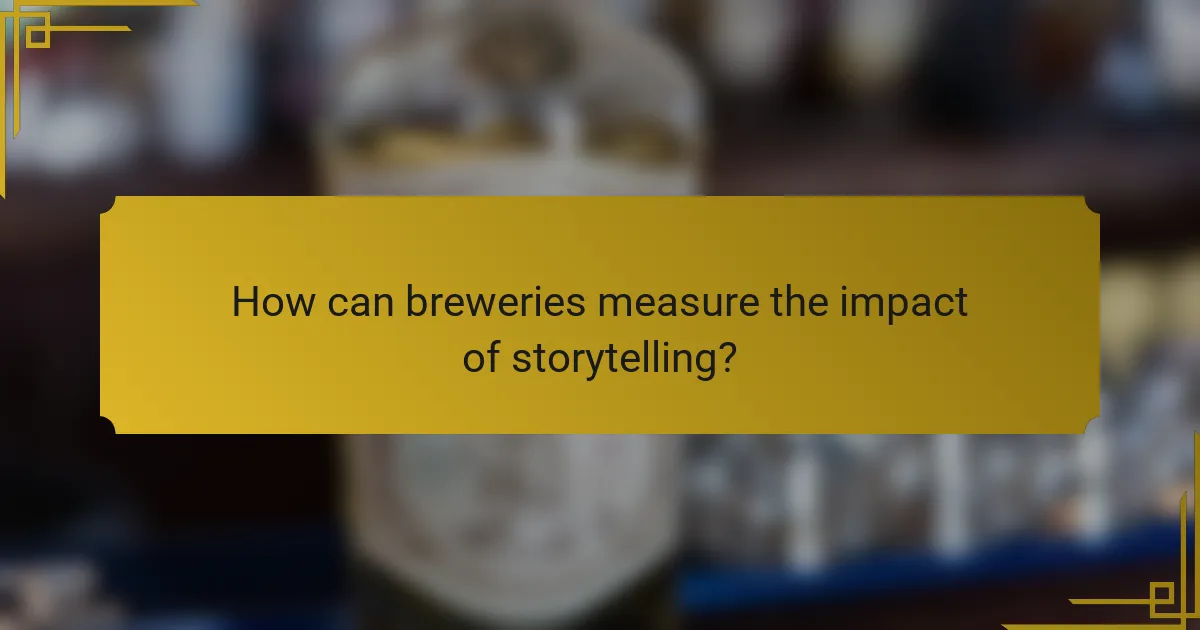Integrating storytelling into your brewery’s marketing strategy can transform how customers perceive your brand, making it more relatable and memorable. In a competitive craft beer market, authentic narratives not only highlight your unique identity but also foster deeper connections with your audience, enhancing brand loyalty. By sharing engaging stories about your products and community, you can effectively differentiate your brewery and resonate with customers on a personal level.

How can storytelling enhance brewery marketing in the United States?
Storytelling can significantly enhance brewery marketing by creating a narrative that resonates with customers, making the brand more relatable and memorable. In the competitive landscape of the U.S. craft beer market, effective storytelling helps breweries differentiate themselves and connect on a deeper level with their audience.
Builds emotional connections
Storytelling fosters emotional connections by sharing the journey behind the brewery, its founders, and the passion that drives its creations. When customers learn about the inspiration behind a particular brew or the challenges faced during its development, they feel more invested in the brand. This emotional tie can lead to a stronger sense of community among patrons.
For example, a brewery might highlight its local sourcing of ingredients, showcasing farmers and suppliers in its storytelling. This not only emphasizes quality but also builds a narrative that resonates with consumers who value sustainability and local businesses.
Increases brand loyalty
When customers connect emotionally through storytelling, they are more likely to develop brand loyalty. A compelling narrative can turn casual drinkers into devoted fans who actively support the brewery. This loyalty often translates into repeat purchases and word-of-mouth referrals, which are crucial in the craft beer industry.
Breweries can enhance loyalty by creating a series of stories around seasonal brews or limited editions, encouraging customers to return to experience the next chapter. Offering loyalty programs that reward customers for sharing their own stories about the brand can further strengthen this bond.
Drives customer engagement
Engaging storytelling invites customers to participate in the brand narrative, whether through social media, events, or brewery tours. By encouraging customers to share their experiences and stories, breweries can create a vibrant community that actively engages with the brand.
For instance, a brewery could host storytelling nights where customers share their own experiences related to beer or brewing. This not only fosters engagement but also provides valuable insights into customer preferences and interests, allowing the brewery to tailor its offerings accordingly.

What are effective storytelling techniques for breweries?
Effective storytelling techniques for breweries involve creating engaging narratives that resonate with customers, enhancing brand loyalty and connection. By sharing authentic stories, breweries can highlight their unique identity and values, making their products more relatable and memorable.
Customer testimonials
Customer testimonials are powerful tools for breweries to showcase real experiences with their products. By featuring quotes or stories from satisfied patrons, breweries can build trust and credibility. Consider using testimonials in marketing materials, on social media, or even on beer labels to create a personal touch.
Encourage customers to share their stories through contests or social media campaigns, offering incentives like discounts or exclusive merchandise. This not only generates content but also fosters community engagement.
Behind-the-scenes narratives
Behind-the-scenes narratives provide insight into the brewing process and the people behind the brand. Sharing stories about the brewing team, the equipment used, or the challenges faced during production can create a deeper connection with consumers. Use videos or blog posts to illustrate these narratives effectively.
Consider hosting brewery tours or virtual events where customers can meet the brewers and learn about the craft. This transparency can enhance customer loyalty and encourage word-of-mouth promotion.
Ingredient sourcing stories
Ingredient sourcing stories highlight the origins of the materials used in brewing, emphasizing quality and sustainability. Sharing where and how ingredients are sourced can resonate with environmentally conscious consumers and those interested in local products. Use maps or infographics to visually represent these connections.
Engage with local farmers or suppliers to create partnerships that can be featured in marketing efforts. This not only supports the local economy but also reinforces the brewery’s commitment to quality and community involvement.

How can breweries implement storytelling in social media?
Breweries can effectively implement storytelling in social media by sharing authentic narratives about their brand, products, and community. This approach helps to create a deeper connection with customers and enhances brand loyalty.
Visual storytelling through Instagram
Instagram is a powerful platform for visual storytelling, allowing breweries to showcase their unique brewing process, ingredients, and atmosphere. High-quality images and engaging captions can highlight the craftsmanship behind each beer, making followers feel part of the journey.
Consider using Instagram Stories to share behind-the-scenes content or customer experiences. Regularly posting user-generated content can also foster community engagement and encourage followers to share their own stories related to your brewery.
Engaging video content on TikTok
TikTok offers breweries an opportunity to create short, engaging videos that tell their story in a fun and creative way. Use this platform to showcase brewing techniques, staff introductions, or even humorous skits that relate to beer culture.
Focus on trends and challenges that resonate with your audience, and consider collaborating with local influencers to expand your reach. Keep videos concise, aiming for a duration of 15 to 60 seconds to maintain viewer interest.
Story-driven posts on Facebook
Facebook allows breweries to share longer, narrative-driven posts that can delve into the history of the brewery, the inspiration behind specific beers, or community events. These stories can foster a sense of connection and encourage discussions among followers.
Utilize Facebook Live to host Q&A sessions or virtual tours, allowing customers to engage directly with the brand. Regularly posting updates about new releases or events can keep your audience informed and excited about your offerings.

What role does brand identity play in storytelling?
Brand identity is crucial in storytelling as it establishes a brewery’s unique personality and values, helping to connect emotionally with customers. A strong brand identity shapes the narrative around the brewery, making it memorable and relatable to its audience.
Defines brand voice
Brand voice is the consistent tone and style used in communication, reflecting the brewery’s identity. For instance, a craft brewery might adopt a playful and informal voice, while a traditional brewery may choose a more refined and formal tone. This consistency helps customers recognize and relate to the brand across various platforms.
To define your brand voice, consider your target audience and the emotions you want to evoke. Create guidelines that outline key phrases, vocabulary, and stylistic choices to maintain uniformity in all messaging, from social media posts to packaging.
Shapes customer perception
Customer perception is influenced by how a brewery tells its story, which can enhance brand loyalty and trust. A compelling narrative about the brewing process, local ingredients, or community involvement can create a positive image and differentiate the brewery from competitors.
To effectively shape perception, share authentic stories that resonate with your audience. Highlight customer testimonials, behind-the-scenes insights, or the history of your brewery. This transparency fosters a deeper connection and encourages customers to choose your brand over others.

How can breweries measure the impact of storytelling?
Breweries can measure the impact of storytelling through various methods that gauge customer response and engagement. By analyzing feedback and interactions, breweries can determine how effectively their narratives resonate with their audience.
Customer feedback surveys
Customer feedback surveys are a direct way to assess how storytelling influences consumer perceptions and preferences. Breweries can create short, targeted surveys that ask specific questions about the stories behind their beers, such as how these narratives affect purchase decisions or brand loyalty.
To maximize effectiveness, consider including open-ended questions that allow customers to express their thoughts in detail. Aim for a response rate of at least 10-20% to ensure the data is representative.
Social media engagement metrics
Social media engagement metrics provide insights into how well storytelling resonates with audiences online. Key metrics include likes, shares, comments, and overall reach, which can indicate how compelling your brewery’s stories are to followers.
Track these metrics over time to identify trends. For instance, a spike in engagement following a storytelling campaign may suggest that the narrative struck a chord with your audience. Regularly analyze these metrics to refine your storytelling approach and enhance customer connection.

What are common pitfalls in brewery storytelling?
Common pitfalls in brewery storytelling include creating inauthentic narratives and overcomplicating the message. These issues can dilute your brand’s identity and confuse potential customers, ultimately hindering your marketing efforts.
Inauthentic narratives
Inauthentic narratives can alienate your audience and damage your brand’s credibility. Customers today value transparency and genuine stories that reflect the true essence of your brewery. For example, if your brewery emphasizes local sourcing but primarily uses ingredients from distant suppliers, this discrepancy can lead to distrust.
To avoid this pitfall, ensure that your storytelling aligns with your actual practices and values. Share real experiences from your brewing process, the people behind the brand, and the community you serve. Authenticity fosters a stronger connection with your audience.
Overcomplicating the message
Overcomplicating your message can confuse potential customers and dilute the impact of your storytelling. When your narrative is filled with jargon or convoluted concepts, it can be difficult for your audience to grasp the core message. Aim for clarity and simplicity to engage effectively.
To keep your message straightforward, focus on key themes that resonate with your target audience. Use relatable language and avoid excessive detail. For instance, instead of detailing every step of the brewing process, highlight the unique aspects that set your beer apart, such as a special ingredient or brewing technique.
